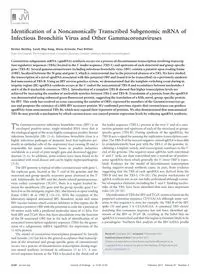
2013 Identification of a Noncanonically Transcribed Subgenomic mRNA of Infectious Bronchitis Virus and Other Gammacorona PDF
Preview 2013 Identification of a Noncanonically Transcribed Subgenomic mRNA of Infectious Bronchitis Virus and Other Gammacorona
Identification of a Noncanonically Transcribed Subgenomic mRNA of Infectious Bronchitis Virus and Other Gammacoronaviruses Kirsten Bentley, Sarah May Keep, Maria Armesto, Paul Britton Avian Viral Diseases, The Pirbright Institute, Compton Laboratory, Compton, Newbury, Berkshire, United Kingdom Coronavirus subgenomic mRNA (sgmRNA) synthesis occurs via a process of discontinuous transcription involving transcrip- tion regulatory sequences (TRSs) located in the 5= leader sequence (TRS-L) and upstream of each structural and group-specific gene (TRS-B). Several gammacoronaviruses including infectious bronchitis virus (IBV) contain a putative open reading frame (ORF), localized between the M gene and gene 5, which is controversial due to the perceived absence of a TRS. We have studied the transcription of a novel sgmRNA associated with this potential ORF and found it to be transcribed via a previously unidenti- fied noncanonical TRS-B. Using an IBV reverse genetics system, we demonstrated that the template-switching event during in- tergenic region (IR) sgmRNA synthesis occurs at the 5= end of the noncanonical TRS-B and recombines between nucleotides 5 and 6 of the 8-nucleotide consensus TRS-L. Introduction of a complete TRS-B showed that higher transcription levels are achieved by increasing the number of nucleotide matches between TRS-L and TRS-B. Translation of a protein from the sgmRNA was demonstrated using enhanced green fluorescent protein, suggesting the translation of a fifth, novel, group-specific protein for IBV. This study has resolved an issue concerning the number of ORFs expressed by members of the Gammacoronavirus ge- nus and proposes the existence of a fifth IBV accessory protein. We confirmed previous reports that coronaviruses can produce sgmRNAs from noncanonical TRS-Bs, which may expand their repertoire of proteins. We also demonstrated that noncanonical TRS-Bs may provide a mechanism by which coronaviruses can control protein expression levels by reducing sgmRNA synthesis. T he Gammacoronavirus infectious bronchitis virus (IBV) is an enveloped positive-sense, single-stranded RNA virus that is the etiological agent of the acute highly contagious poultry disease infectious bronchitis (IB) (1–4). Infectious bronchitis virus is a highly infectious pathogen of domestic fowl that replicates pri- marily in epithelial cells of the respiratory tract causing IB and is responsible for major economic losses to poultry industries worldwide as a result of poor weight gain and decreased egg pro- duction (5, 6). In addition, some isolates have been found to be associated with renal disease and can be highly nephropathogenic (7–9). The IBV genome is typical of other coronaviruses with gene 1, the replicase gene, located at the 5= end of the genome and the structural and group-specific accessory genes clustered at the 3= end. Additionally, for IBV and the closely related gammacorona- virus turkey coronavirus (TCoV), there is a region located be- tween the membrane (M) gene and the group-specific gene 5 re- ferred to as the intergenic region (IR), also known as open reading frame (ORF) 4b or ORF X (10–13). With the exception of the laboratory-adapted attenuated IBV Beaudette strain and some IBV vaccine isolates which contain deletions in this region, the IR contains a putative ORF with the potential to code for a protein of 94 amino acids with a predicted molecular mass of 11 kDa. For both IBV and TCoV there has been speculation over the function of the IR-associated ORF due to the lack of identification of an associated transcription regulatory sequence (TRS) for the gener- ation of a subgenomic mRNA (sgmRNA) for expression of the 11-kDa protein. The model of coronavirus transcription proposed by Sawicki and Sawicki (14) has led to the general acceptance that transcrip- tion of the structural and group-specific genes of coronaviruses occurs via a process of discontinuous transcription during nega- tive-strand synthesis (reviewed in references 15 to 17). A con- served sequence known as the TRS is located at the distal end of the leader sequence (TRS-L) present at the very 5= end of a coro- navirus genome and upstream of each of the structural or group- specific genes (TRS-B). During synthesis of the sgmRNAs, the TRS-B acts a signal for pausing the replication transcription com- plex. The TRS-B of the nascent negative-strand sgRNA is then able to complementarily base pair with the TRS-L of the genome, fa- cilitating a template switch, and transcription continues to the 5= end of the genome. The negative-sense sgRNAs, with coterminal 5= and 3= ends, are then transcribed into a nested set of positive- sense sgmRNAs from which generally the 5=-most ORF is trans- lated. Evidence for the model of discontinuous transcription during negative-strand synthesis came, in part, from evidence suggesting that the TRS of each sgmRNA was derived from the TRS-B and not the TRS-L (18–20). The precise mechanisms of sgRNA synthesis are, as yet, not fully understood although a num- ber of sequence elements, including the 5= and 3= flanking nucleo- tides of the TRS, have been identified that may have important roles (18, 20–26). Identification of TRSs for IBV and TCoV strains is based on the proposed consensus sequence CUUAACAA although some vari- ation in this sequence is seen; for example, the TRS-B of the IBV spike (S) and gene 3 is CUGAACAA. A canonical TRS closely matching this consensus sequence has not been identified up- stream of the IBV or TCoV IR, resulting in the belief that no sgmRNA is transcribed and that this region is therefore likely to be a pseudogene. Northern blot analysis of the IBV mRNA profile Received 22 October 2012 Accepted 27 November 2012 Published ahead of print 5 December 2012 Address correspondence to Paul Britton,
